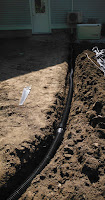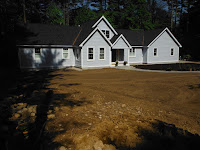 |
| Our new home respects the wetlands that make up two-thirds of the property |
The evening before the beginning of The Great Replacement,
Betty and I walked our property with Scott Dolan, a Medfield-based
landscaper. Using orange paint we marked
the placement of a patio, sidewalk and stone wall. We discussed grade levels
and ideal pitch; and how to ensure that we did not injure the wetlands behind
our home.
We also marked where crushed rock drains would obviate the
need for gutters in front of the house, and where a berm would be created to
provide a measure of privacy from the street.
At the end of an hour, we all understood the exact scope of the work
ahead of us.
 |
| Below the builder's crud on the surface was more of the same |
Then, on Wednesday, May 20, a convoy of trucks, bulldozers
and backhoes descended on 26 Pine Street and began The Great Replacement. The goal: make a little over 20,000 square
feet of land suitable for creating a garden.
Our new garden is being created from a blank slate. The house that previously stood on the site
was beyond repair; we had it torn down.
There was no garden. The lot was
densely wooded with end-of-life white pines.
Underneath those pines were a morass of invasive burning bush. Surrounding the burning bush were sweeps of
horrific black swallowwort.
 |
| We excavated down 18 inches, removing more than 900 cubic yards of detritus... |
More than forty pines became board lumber and mulch; the
invasive detritus was stripped away. A
barrier was erected between the buildable portion of the property and an
acre-plus of wetlands behind it. A home
rose on the site.
Material from the digging of the basement, coupled with
other fill, was used to form the open area around the house. But the already rocky fill was continually
compressed by trucks and cranes. Over
the winter, it hardened into something with the consistency of concrete. Our
attempts to dig even small holes were exercises in frustration. What was needed was a major-league do-over. Hence Scott Dolan and his armada of yellow
Caterpillar equipment.
 |
| ... replacing it with screened loam. Note the laser depth measurement tool |
It takes a very good landscaper to accept a project like
ours, much less to do it with enthusiasm.
For somebody in the business, the real money in landscaping is in
creating extravagant ‘hardscapes’ that dazzle visitors and homeowners alike
and, after that, in the continuing maintenance of lawns and shrubs. Our project, on the other hand, was a
one-time, low-margin deal. But it was a
monumental undertaking: scrape out the
top eighteen inches of crud on those 20,000 square feet, haul it away, and replace
it with a like amount of screened loam.
* * * * *
 |
| At the same time, we prepped for the installation of a sidewalk... |
Though the work was being done by Scott’s crew, I was on
hand that first morning to rescue large rocks for the to-be-built stone wall,
darting in between each scoop to pick up ones of a usable size and shape. Each scoop revealed what we already
suspected: beneath the ‘builder’s crud’ on the surface of our new home’s land
was more crud. The mix was more than 50%
rock to soil.
What was interesting, though, was that further down – below
the original grade – was a mixture of soil and river gravel. At one time, our property had likely been
part of a river bed. Once the crud was
gone, we would have great drainage.
 |
| We also created a drainage network |
Using laser-guided measuring tools, backhoes removed those
useless top eighteen inches. A lineup of
trucks hauled it away to a construction project in another town that needed
fill (just as much of our ‘crud’ had its origins from another excavation).
Even as the digging-out process continued in the front of
the property, trucks began bringing in screened loam to the back. Our loam came from a farm in a nearby town
that has been sold and will soon begin to sprout homes. We spot checked the loam as it came in: it was rock-free and rich in organics. This was the beginning of a great garden.
 |
| We topped the newly installed loam with several inches of dark brown mulch |
It took three days to replace those top eighteen inches. A portion of that third day was devoted to
making the property ready for a sidewalk, a patio, and a proper porous stone
driveway (there will be no asphalt on the site). A re-processed concrete material forms the
base of the patio and sidewalk. It was
tamped into a hard-pack surface. At dusk
on Friday, Scott’s part of the job was done.
 |
| Now, all we have to do is add several thousand plants... |
Betty’s and my part of the job was just beginning. On Saturday morning, a massive truck
delivered twenty cubic yards of dark brown mulch. As this is written we are still spreading it
over the new loam. The purpose is to
prevent the soil from blowing and to retain the soil's moisture.
Twenty yards will not be sufficient to cover all the areas.
Also on Saturday, we went window shopping (or its open-air
equivalent) for stone for the sidewalk and patio. I had gone into the process with a fairly
narrow view of what would be acceptable for those two elements of our
hardscape. My eyes were opened to a
world of possibilities, including cleft Pennsylvania fieldstone, Sekonnet round
stone, and a host of names that overwhelmed me with new choices. All I can say is that ‘bluestone’ has a lot
of competition.
On Sunday, we started shopping for trees and shrubs. But that’s another story.



